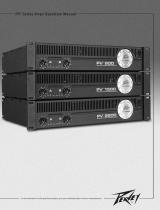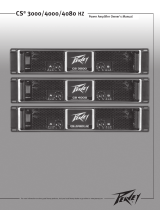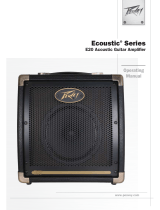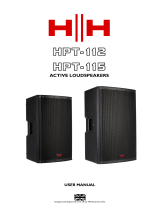Page is loading ...

www.peavey.com
Feedback Ferret
®
D
precision stereo digital dynamic
anit-feedback filter array
Operating
Manual

IMPORTANT SAFETY INSTRUCTIONS
WARNING: When using electrical products, basic cautions should always be followed, including the following:
1. Read these instructions.
2. Keep these instructions.
. Heed all warnings.
4. Follow all instructions.
5. Do not use this apparatus near water.
6. Clean only with a dry cloth.
7. Do not block any of the ventilation openings. Install in accordance with manufacturer’s instructions.
8. Do not install near any heat sources such as radiators, heat registers, stoves or other apparatus (including amplifiers)
that produce heat.
9. Do not defeat the safety purpose of the polarized or grounding-type plug. A polarized plug has two blades with one
wider than the other. A grounding type plug has two blades and a third grounding plug. The wide blade or third prong is
provided for your safety. If the provided plug does not fit into your outlet, consult an electrician for replacement of the
obsolete outlet.
10. Protect the power cord from being walked on or pinched, particularly at plugs, convenience receptacles, and the point
they exit from the apparatus.
11. Only use attachments/accessories provided by the manufacturer.
12. Use only with a cart, stand, tripod, bracket, or table specified by the manufacturer, or sold with the apparatus. When a
cart is used, use caution when moving the cart/apparatus combination to avoid injury from tip-over.
1. Unplug this apparatus during lightning storms or when unused for long periods of time.
14. Refer all servicing to qualified service personnel. Servicing is required when the apparatus has been damaged in
any way, such as when power-supply cord or plug is damaged, liquid has been spilled or objects have fallen into the
apparatus, the apparatus has been exposed to rain or moisture, does not operate normally, or has been dropped.
15. Never break off the ground pin. Write for our free booklet “Shock Hazard and Grounding.” Connect only to a power
supply of the type marked on the unit adjacent to the power supply cord.
16. If this product is to be mounted in an equipment rack, rear support should be provided.
17. Note for UK only: If the colors of the wires in the mains lead of this unit do not correspond with the terminals in your
plug‚ proceed as follows:
a) The wire that is colored green and yellow must be connected to the terminal that is marked by the letter E‚ the earth
symbol‚ colored green or colored green and yellow.
b) The wire that is colored blue must be connected to the terminal that is marked with the letter N or the color black.
c) The wire that is colored brown must be connected to the terminal that is marked with the letter L or the color red.
18. This electrical apparatus should not be exposed to dripping or splashing and care should be taken not to place objects
containing liquids, such as vases, upon the apparatus.
19. Exposure to extremely high noise levels may cause a permanent hearing loss. Individuals vary considerably in suscep-
tibility to noise-induced hearing loss, but nearly everyone will lose some hearing if exposed to sufficiently intense noise
for a sufficient time. The U.S. Government’s Occupational Safety and Health Administration (OSHA) has specified the
following permissible noise level exposures:
Duration Per Day In Hours Sound Level dBA, Slow Response
8 90
6 92
4 95
97
2 100
1 1⁄2 102
1 105
1⁄2 110
1⁄4 or less 115
According to OSHA, any exposure in excess of the above permissible limits could result in some hearing loss. Earplugs or protectors to
the ear canals or over the ears must be worn when operating this amplification system in order to prevent a permanent hearing loss, if
exposure is in excess of the limits as set forth above. To ensure against potentially dangerous exposure to high sound pressure levels, it is
recommended that all persons exposed to equipment capable of producing high sound pressure levels such as this amplification system be
protected by hearing protectors while this unit is in operation.
SAVE THESE INSTRUCTIONS!

7
Feedback Ferret® D
precision stereo digital dynamic anti-feedback lter array
Find it and eliminate it. The Feedback Ferret D solves your feedback problems automatically. With the Feedback Ferret D
Dual Channel Digital Anti-Feedback System on the job, feedback can be eliminated in stereo, or eliminated independently in
either channel when configured as a dual mono processor. The Feedback Ferret D features precise digital filters, fast feedback
analysis and an audio friendly approach to feedback elimination.
The Feedback Ferret D applies 16 stereo digital dynamic filters (or 2 filters in dual mono mode) at a resolution of 24-bits,
automatically controlling feedback without sacrificing volume or tone. The Feedback Ferret D, armed with sophisticated
algorithms, distinguishes between music and feedback, seeking and destroying the feedback, leaving your music alone.
Although there is no substitute for a good soundperson, the Feedback Ferret D can greatly improve your sound application.
Please read this guide carefully to ensure your personal safety as well as the safety of your equipment.
FEATURES:
• Sophisticated seek and destroy algorithms that find‚ lock in and reduce offending frequencies
• 24-bit converters and a sample rate of 48 kHz
• 16 stereo, dynamically controlled digital notch filters (or 32 filters in dual mono mode) configured for 1/12 octave
performance give the Feedback Ferret D more feedback control than any other unit on the market
• Four preset locations allow you to store settings for your most common performance venues
• Disable button located on rear panel allows you to quickly disable the front panel once your settings are made
• +4 or -10 dB switches on each in/out
• Wide/Narrow button changes the width of filters
• Reset button resets some or all of the filters
ENGLISH
QUICK SETUP
1. Turn off power to all units in your signal path.
2. Insert the Feedback Ferret D into your signal path between the mixer and power amp. Make sure your speakers are
connected. Connect the mixer’s main output and/or monitor output (depending on your application) to the Feedback
Ferret D’s input. Connect one of the Feedback Ferret D’s outputs to the power amp input. Connect all microphones.
. Power up all units with the master volume completely down. (Remember: You should turn your power amp on last
and off rst.) Make sure the Feedback Ferret D is set to Fixed Filter Learn (LED ON). (Remember: you want a fairly
quiet room with the microphone levels up and no signal going through the system.)
4. Slowly bring up the master volume. The Feedback Ferret D starts to work as feedback occurs‚ beginning with
lter 1. The lter LEDs will blink as the lters are needed‚ letting you know that a feedback frequency has been found
and the lter dened. Expect some LEDs to light solidly as lters lock down on a problem! Increases the volume only
as much as needed.
5. Once the feedback is eliminated and lters are set‚ depress the Normal button on the front panel of the Feedback
Ferret D and return the mixer gain to a normal level. That’s it! Your Feedback Ferret D is working for you.
FOR BEST RESULTS, PLEASE READ THE ENTIRE OPERATING GUIDE.

8
Input Signal
The SIG LED illuminates when a signal is present (40 dB down from full scale). The CLIP LED lights when
the signal is 1/2 dB down from clipping.
Bypass
To bypass the Feedback Ferret D, press and hold the reset button until the LED stops blinking and has
constant illumination. This bypasses all feedback lters. USE CAUTION WHEN BYPASSING THE Feedback
Ferret D. Feedback could occur again ---- Very Loudly!
Reset
The Reset button has two stages. By pressing and holding the reset button‚ all lter LEDs will begin to
ash. Filters 9–16 (dynamic) will clear rst, as indicated by their non-lit LEDs. Releasing the button at
this point will leave the static lters (1–8) in their current state. Continuing to hold the reset button will
clear the remaining lters 1–8 (static).
Notch Wide
Engaging the Wide button increases the range of frequencies each lter affects. The LED illuminates
when Wide is activated. (Note: Feedback often occurs around a range of pitches or frequencies‚ not
necessarily at a single pitch. By engaging this button‚ the Feedback Ferret D widens the effective range
of each lter and subsequently uses fewer lters to accomplish the same result.)
Panic Mode (Quick Filter)
Panic lters are a special class of lters designed to quickly control sudden‚ extreme feedback. Panic is
automatically engaged in Normal operating mode. The LED illuminates when Panic is activated.
Setup/Preset
This switch toggles the next bank of buttons between SETUP mode and PRESET mode.
Preset Mode (LED on)
The four buttons labeled 1-4 are used to store and recall Feedback Ferret D settings. To store, press and
hold the desired preset button until the LED stops blinking. To recall a stored preset, press the corre-
sponding preset button.
Note: using the power up recall switch on the rear panel, the Feedback Ferret D can be set to recall
preset 1 automatically each time the power is turned on.
Setup Mode (LED off)
In this mode the four function buttons each take on a separate function as indicated on the front panel.
Normal/Filter Learn
FILTER LEARN mode is used to preempt feedback by setting xed lters before the performance starts.
Pressing the button will turn the LED on to indicate you are no longer in NORMAL operation mode. To
take advantage of this mode, see “Operating Instructions” later in the manual.
Front Panel
1
2
3
4
5
6
7
8
1 2 3
4
5
6
7
9

9
Front Panel
Stereo/Mono
This button and LED combination is used to select Stereo or Dual Mono as the Feedback Ferret D's oper-
ating mode. This feature adds great exibility. In stereo mode, the Feedback Ferret D reacts to feedback
in both the left and right channels by conguring stereo lters. In dual mono mode, each channel of the
Feedback Ferret D acts independently to seek out and eliminate feedback. In dual mono mode the left
and right channel selector buttons are used to switch the display and function buttons between chan-
nels.
Mono View Left and Mono View Right
These buttons are used to switch the front panel buttons and display between channels in the dual
mono mode. The LED for the selected channel will be lit.
Lock
Stops the Feedback Ferret D from setting any new lters but keeps the lters already dened in place.
Filters
There are two sets of lters on the Feedback Ferret D. Filters 1–8 are static and always set before the
dynamic lters. Once these static lters are dened‚ they lock and maintain their status until they are
reset. The dynamic lters (9–16) are those lters that change as input changes (i.e., volume changes‚
etc.).
Power (On)
This LED illuminates when AC power is supplied and the power switch is on.
11
14
12
13 14
10
13

Rear Panel
10
AC Power
This is a standard IEC power connector. A mains cord with the appropriate AC plug and ratings for the
intended operating voltage is included. The mains cord should be connected to the unit before plugging
into a suitable AC outlet.
Fuse
Domestic: 1 Amp Slow-Blow
Export: 500 mA Time Delay
Power Switch
This switch supplies AC mains power to the internal power supply. When the unit is functioning‚ the
Power LED on the front panel will illuminate.
Front Panel Disable Switch
When the Disable switch is engaged‚ all buttons on the front of the unit are disabled. Use this switch to
prevent accidental changes to your settings once you’ve set up your system.
Power-Up Recall
This button determines‚ upon powering up‚ whether the unit recalls the last settings used or preset 1.
Outputs
1/4” TRS balanced audio outputs
[tip = positive; ring = negative; sleeve = ground]
XLR balanced audio outputs
[pin 1 = ground; pin 2 = positive; pin = negative]
unbalanced
[tip = positive; sleeve = ground]
Inputs
XLR and 1/4” combo jack, 1/4” TRS balanced audio inputs
[tip = positive; ring = negative; sleeve = ground]
XLR balanced audio inputs
[pin 1 = ground; pin 2 = positive; pin = negative]
unbalanced
[tip = positive; sleeve = ground]
16
19
17
15
16
17
15
18
20
21
18
19
20 21

11
Feedback Ferret
®
D Specications
Features and specifications subject to change without notice.
Input Impedance:
40 k ohm
Output Impedance:
120 k ohm
Dynamic Range:
10 dBr @ 1 kHz ref to
+18 dBu Output
22 Hz to 22 kHz unweighted
Total Harmonic Distortion:
0.005% @ 1 kHz typical
Input Sensitivity:
+4 dBu nominal,
+18 dBu full scale
Output Drive:
+4 dBu nominal
+18 dBu full scale
Dimensions:
Width: 19.000" (48.26cm)
Depth: 8.000" (20.2cm)
Height: 1.750" (4.45 cm)
Weight: 7.1 lbs (.95 kg)
Power:
Domestic:120VAC; 60 Hz; 25 Watts
Export:20 VAC; 50/60 Hz; 25 Watts
Bypass:
True power-off bypass
Mounting:
One EIA rack space
Connections:
Balanced combo female
XLR/female 1/4" TRS for input
Separate balanced male XLR and
female 1/4" TRS for output
Sample Rate:
48 kHz
Converters:
24 bit
Frequency Response:
+/- 0.5 dB
(20 Hz to 20 kHz, ref. 1 kHz)
Input Level:
+4 dBu
Output Level:
+4 dBu
Gain:
Unity balanced
-6 dB unbalanced
Other Back Panel Controls:
Front panel disable
Power-up recall select

12
Operating Instructions
Where To Put Your Feedback Ferret
®
D
The Feedback Ferret D can be used in a variety of locations within a sound system. Place a Feedback
Ferret D at the input insert of every microphone, or process multiple microphones together by placing a
single Feedback Ferret D on the output of a vocal subgroup. One of the most common uses is to install
the Feedback Ferret D between the power amp’s input and the mixer’s output (the main output or the
monitor output‚ depending on your needs). You can also place the Feedback Ferret D on a single chan-
nel’s insert to eliminate feedback from a single microphone or instrument. Once the Feedback Ferret D
has determined the problem frequencies for a particular setup‚ you can save that group of lter settings
to one of the four preset buttons for instant recall.
How Does It Work?
The Feedback Ferret D’s dual sets of 16 digital notch lters employ sophisticated algorithms to seek and
destroy feedback without destroying your tone. There are two sets of lters on the Feedback Ferret D‚
static and dynamic. Filters 1–8 are static and always set before the dynamic lters (9–16). Once these
static lters are set‚ they lock and maintain their status until the user either resets them or selects a pre-
set. The dynamic lters (9–16) are those that change as your needs change. Any lter (static or dynamic)
that is set but not locked in (as indicated by blinking lter LED) will slowly return to at (0 dB) and be
available for use.
The Feedback Ferret D applies a lter when it locates an offending frequency (feedback)‚ starting with
lter 1. This lter is centered at the feedback frequency and uses only as much attenuation as needed
to remove the feedback. If feedback continues‚ the lter depth is progressively increased until the
feedback is gone. If the feedback is momentary‚ such as a short squeal‚ the Feedback Ferret D applies
a lter but slowly releases it in .10 dB steps until it is returned to at (0 dB). If the same frequency
causes feedback again‚ the same lter will be reapplied. This process continues as additional lters are
engaged until all feedback is gone. Monitoring continues as the Feedback Ferret D attempts to release
each active unlocked lter .10 dB at a time. Once a lter reaches 0 dB‚ the Feedback Ferret D returns the
lter to the available queue.

13
Set-up
Setup (Filter Learn)
For best results‚ complete the Filter Learn in a relatively quiet room. This allows the Feedback Ferret D to
nd primary acoustic feedback frequencies. Every room and setup has problem frequencies. This makes
each room different and creates different feedback problems. It is important to understand that while in
Filter Learn mode‚ the Feedback Ferret D does not distinguish between feedback and music. If you play
music through the system while in Filter Learn mode‚ theFeedback Ferret D will try to eliminate it.
Step One
These instructions assume you have connected the Feedback Ferret D from the mixer outputs and not
from a single channel insert. Make sure that the Normal/Filter Learn LED is lit (this engages Filter Learn
Mode) and that your microphone levels are set. Slowly bring up the master level. You should see the l-
ters seek and lock as feedback starts to occur. The Feedback Ferret D will begin with lter 1 and progress
from left to right automatically. You will notice that each lter will rst blink and then light solidly as
each frequency is locked down. This is accomplished with the minimum amount of
attenuation.
Step Two
Continue bringing the master level up until you’ve reached the required volume level. As you start to
hear feedback‚ stop adjusting the levels momentarily to allow the Feedback Ferret D to complete its
lter adjustment. Normally‚ you should hear the onset of feedback before the Feedback Ferret D takes
control. In most applications‚ this should give you plenty of gain and still leave additional lters open
for later use. If all or most of the lter LEDs are lit up‚ bring the master level back down‚ reset the lters
and start over. But this time‚ push the Wide button on the front panel. This allows each lter to work on
a wider range of frequencies, thereby freeing up additional lters for other uses. A typical room should
only set one to six lters during this soundcheck setup. (Note: If all or most of the lter LEDs light up,
this probably indicates a bad room‚ bad system setup or too much volume!)
Step Three
Finally‚ switch the unit to Normal (Filter Learn Off) mode. This automatically engages the Panic button.
Your system should now be performance-ready! At this point‚ it is advisable to engage the Front Panel
Disable Switch in order to minimize accidental changes. Once you are content with your settings‚ press
and hold one of the preset buttons (1–4) to save your lter settings.
Note: The Feedback Ferret D is not a replacement for a good soundperson. Good sound system
performance starts with good microphone and speaker placement.

15
PEAVEY ELECTRONICS CORPORATION LIMITED WARRANTY
Effective Date: July 1, 1998
What This Warranty Covers
Your Peavey Warranty covers defects in material and workmanship in Peavey products purchased and serviced in the U.S.A. and Canada.
What This Warranty Does Not Cover
The Warranty does not cover: (1) damage caused by accident, misuse, abuse, improper installation or operation, rental, product modification or neglect; (2) dam-
age occurring during shipment; () damage caused by repair or service performed by persons not authorized by Peavey; (4) products on which the serial number
has been altered, defaced or removed; (5) products not purchased from an Authorized Peavey Dealer.
Who This Warranty Protects
This Warranty protects only the original retail purchaser of the product.
How Long This Warranty Lasts
The Warranty begins on the date of purchase by the original retail purchaser. The duration of the Warranty is as follows:
Product Category Duration
Guitars/Basses, Amplifiers, Pre-Amplifiers, Mixers, Electronic
Crossovers and Equalizers 2 years (+ 3 years)*
Drums 2 years (+ 1 year)*
Enclosures 3 years (+ 2 years)*
Digital Effect Devices and Keyboard and MIDI Controllers 1 year (+ 1 year)*
Microphones 2 years
Speaker Components (incl. speakers, baskets, drivers,
diaphragm replacement kits and passive crossovers)
and all Accessories 1 year
Tubes and Meters 90 days
[*Denotes additional warranty period applicable if optional Warranty Registration Card is completed and returned to Peavey by original retail purchaser within
90 days of purchase.]
What Peavey Will Do
We will repair or replace (at Peavey's discretion) products covered by warranty at no charge for labor or materials. If the product or component must be shipped to
Peavey for warranty service, the consumer must pay initial shipping charges. If the repairs are covered by warranty, Peavey will pay the return shipping charges.
How To Get Warranty Service
(1) Take the defective item and your sales receipt or other proof of date of purchase to your Authorized Peavey Dealer or Authorized Peavey Service Center.
OR
(2) Ship the defective item, prepaid, to Peavey Electronics Corporation, International Service Center, 412 Highway 11 & 80 East, Meridian, MS 901 or Peavey
Canada Ltd., 95 Shields Court, Markham, Ontario, Canada LR 9T5. Include a detailed description of the problem, together with a copy of your sales receipt or
other proof of date of purchase as evidence of warranty coverage. Also provide a complete return address.
Limitation of Implied Warranties
ANY IMPLIED WARRANTIES, INCLUDING WARRANTIES OF MERCHANTABILITY AND FITNESS FOR A PARTICULAR PURPOSE, ARE LIMITED IN DURATION TO THE
LENGTH OF THIS WARRANTY.
Some states do not allow limitations on how long an implied warranty lasts, so the above limitation may not apply to you.
Exclusions of Damages
PEAVEY'S LIABILITY FOR ANY DEFECTIVE PRODUCT IS LIMITED TO THE REPAIR OR REPLACEMENT OF THE PRODUCT, AT PEAVEY'S OPTION. IF WE ELECT TO
REPLACE THE PRODUCT, THE REPLACEMENT MAY BE A RECONDITIONED UNIT. PEAVEY SHALL NOT BE LIABLE FOR DAMAGES BASED ON INCONVENIENCE, LOSS OF
USE, LOST PROFITS, LOST SAVINGS, DAMAGE TO ANY OTHER EQUIPMENT OR OTHER ITEMS AT THE SITE OF USE, OR ANY OTHER DAMAGES WHETHER INCIDENTAL,
CONSEQUENTIAL OR OTHERWISE, EVEN IF PEAVEY HAS BEEN ADVISED OF THE POSSIBILITY OF SUCH DAMAGES.
Some states do not allow the exclusion or limitation of incidental or consequential damages, so the above limitation or exclusion may not
apply to you.
This Warranty gives you specific legal rights, and you may also have other rights which vary from state to state.
If you have any questions about this warranty or service received or if you need assistance in locating an Authorized Service Center, please contact the Peavey
International Service Center at (601) 48-565 / Peavey Canada Ltd. at (905) 475-2578.
Features and specifications subject to change without notice.
Logo referenced in Directive 2002/96/EC Annex IV
(OJ(L)37/38,13.02.03 and defined in EN 50419: 2005
The bar is the symbol for marking of new waste and
is applied only to equipment manufactured after
13 August 2005

Features and specifications subject to change without notice.
Peavey Electronics Corporation • 5022 Hartley Peavey Dr • Meridian, MS 905
(601) 48-565 • FAX (601) 486-1278 • www.peavey.com
© 2005 800161
/





